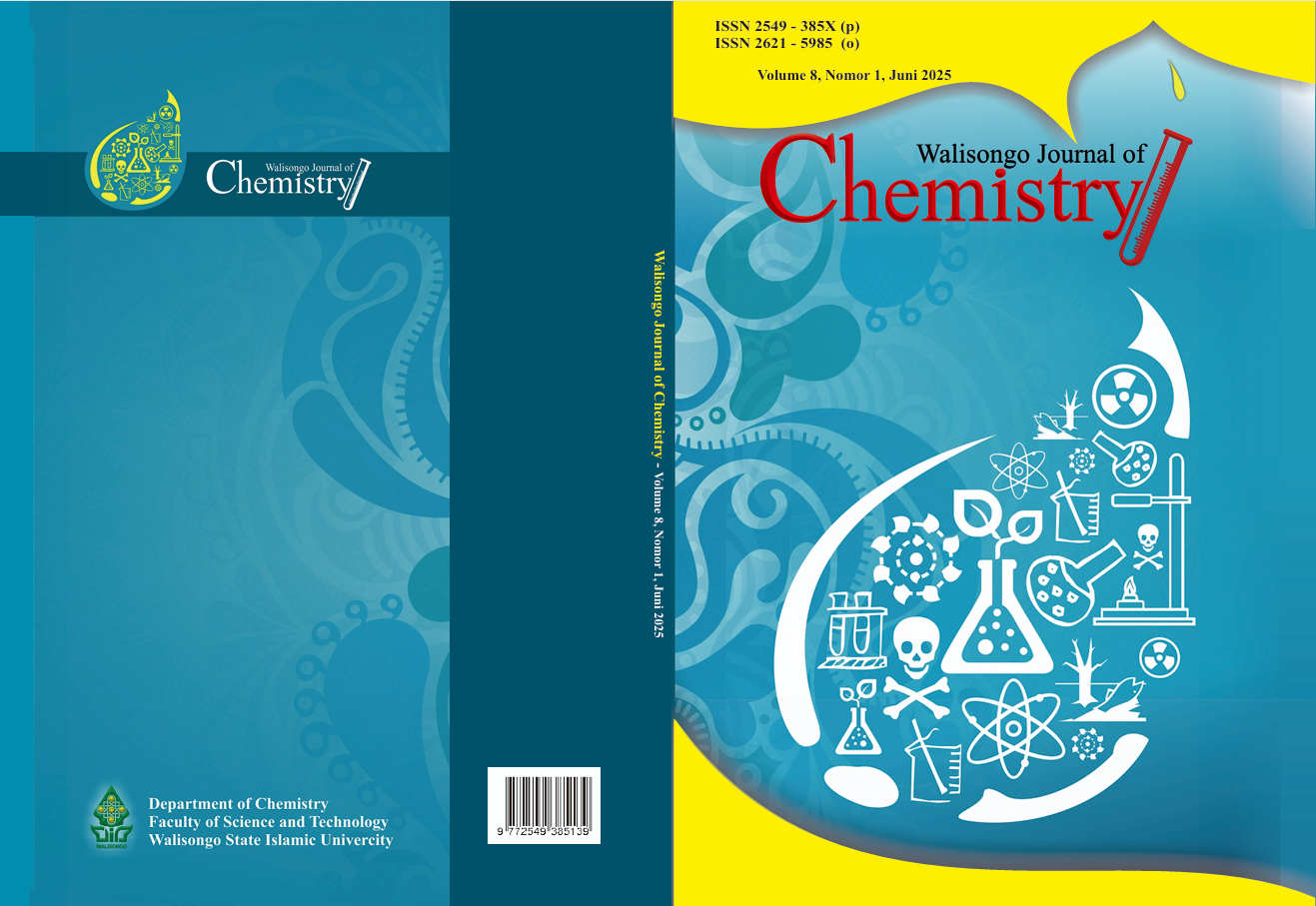CONDUCTIVITY OF SODIUM HALIDES IN BINARY MIXTURES OF ETHYLENE AND PROPYLENE GLYCOL WITH WATER
DOI:
https://doi.org/10.21580/wjc.v8i1.25608Abstract
The conductivity behavior of sodium halides (NaBr and NaCl) in binary solvent mixtures of water with ethylene glycol (EG) and propylene glycol (PG) is crucial for optimizing electrolyte formulations in industrial applications. This study investigated the effects of varying glycol mole fractions (0 to 0.9) and salt concentrations (0.01 g to 0.13 g) on specific conductivity. The measurements were performed using a calibrated conductivity meter at room temperature (30 ± 2°C). The results revealed distinct patterns affected by solvent composition and salt type. In PG-water mixtures, specific conductivity increased with higher PG content; NaBr values rose from 1.02 μS/cm at a 0 mole fraction to 5.78 μS/cm at a 0.9 mole fraction for 0.01 g of NaBr. NaCl showed a similar but less pronounced trend, ranging from 0.4 μS/cm to 2.02 μS/cm under comparable conditions. Conversely, EG-water mixtures exhibited decreasing conductivity with increasing EG content, as NaBr values declined from 7.45 μS/cm at 0 mole fraction to 0.67 μS/cm at 0.9 mole fraction. These higher conductivity values of NaBr were attributed to its larger ionic radius and greater ionic mobility. These findings shed lights on ion–solvent interactions in mixed-solvent systems and have potential applications in electrolytic processes, energy storage, and industrial formulations requiring precise conductivity control.
Downloads
References
Azizian, S., & Hemmati, M. (2003). Surface tension of binary mixtures of ethanol + ethylene glycol from 20 to 50 °C. Journal of Chemical & Engineering Data, 48(3), 662–663. https://pubs.acs.org/doi/10.1021/je025639s
Bezuglaya, E., Krasnopyorova, A., Liapunova, A., Zinchenko, I., Lyapunov, N., & Sytnik, O. (2023). Influence of physicochemical properties and structure of mixed solvents propylene glycol–macrogol 400 on their in vitro release. Scientific Pharmaceutical Sciences, 1(41), 4–13. http://dx.doi.org/10.15587/2519-4852.2023.274468
Cookey, G. A., & Iboroma, D. S. (2023). Conductivity study of sodium bromide and sodium chloride salts in binary mixtures of aqueous and organic solvents. Journal of Chemical Society of Nigeria, 48(2) https://doi.org/10.46602/jcsn.v48i2.873
Cookey, G. A., Obunwo, C. C., & Uzoma, D. O. (2015). The effect of temperature on the micellization of an anionic surfactant in mixed solvent systems. IOSR Journal of Applied Chemistry, 8(12), 49–54.
Dabagh, F., Khalili, F., Zarghampour, A., Hemmati, S., Hanaee, J., & Rahimpour, E. (2024). Investigation of the solubility and thermodynamics of salicylic acid in 2-propanol and ethylene glycol/propylene glycol binary solvent mixtures at (293.15 to 313.15) K. BMC Chemistry, 18(1), 84. https://doi.org/10.1186/s13065-024-01188-1
Dufrêche, J.-F., Bernard, O., Durand-Vidal, S., & Turq, P. (2005). Analytical theories of transport in concentrated electrolyte solutions from the MSA. Journal of Physical Chemistry B, 109(20), 9873–9884. https://pubs.acs.org/doi/10.1021/jp050387y
Mizuhata, M. (2022). Electrical conductivity measurement of electrolyte solution. Electrochemistry, 90(10), 102011. http://dx.doi.org/10.5796/electrochemistry.22-66111
Qie, Y., Wang, S., Fu, S., Xie, H., Sun, Q., & Jena, P. (2020). Yttrium–sodium halides as promising solid-state electrolytes with high ionic conductivity and stability for Na-ion batteries. Journal of Physical Chemistry Letters, 11(9), 3376–3383. https://pubs.acs.org/doi/10.1021/acs.jpclett.0c00010
Sedghamiz, M. A., & Raeissi, S. (2018). Physical properties of deep eutectic solvents formed by the sodium halide salts and ethylene glycol, and their mixtures with water. Journal of Molecular Liquids, 269, 694–702. https://doi.org/10.1016/j.molliq.2018.08.045
Shao, Y., Gudla, H., Mindemark, J., Brandell, D., & Zhang, C. (2024). Ion transport in polymer electrolytes: Building new bridges between experiment and molecular simulation. Accounts of Chemical Research, 57(8), 1123–1134. https://pubs.acs.org/doi/10.1021/acs.accounts.3c00791
Sharygin, A. V., Mokbel, I., Xiao, C., & Wood, R. H. (2001). Tests of equations for the electrical conductance of electrolyte mixtures: Measurements of association of NaCl (aq) and Na₂SO₄ (aq) at high temperatures. The Journal of Physical Chemistry B, 105(1), 229–237. https://pubs.acs.org/doi/10.1021/jp002564v
Talukdar, M., Singh, S., & Dehury, S. K. (2020). A review on conductometric studies of electrolytes in mixed solvent systems to understand ion-ion and ion-solvent interactions. Biointerface Res. Appl. Chem., 10(2), 5332-5337
Uchida, S., & Kiyobayashi, T. (2021). How does the solvent composition influence the transport properties of electrolyte solutions? LiPF₆ and LiFSA in EC and DMC binary solvent. Physical Chemistry Chemical Physics, 23(18), 10875–10887. https://doi.org/10.1039/D1CP00967B
Yang, H., & Wu, N. (2022). Ionic conductivity and ion transport mechanisms of solid-state lithium-ion battery electrolytes: A review. Energy Science & Engineering, 10(5), 1643–1671. https://ui.adsabs.harvard.edu/link_gateway/2022EneSE.10.1643Y/doi:10.1002/ese3.1163
Zarghampour, A., Jafari, P., Rahimpour, E., & Jouyban, A. (2024). Thermodynamic investigation on the aqueous mixtures of choline chloride/propylene glycol deep eutectic solvent at T = (293.15 to 313.15) K. BMC Chemistry, 18(1), 51. http://dx.doi.org/10.1186/s13065-024-01153-y.
Downloads
Published
How to Cite
Issue
Section
License

This work is licensed under a Creative Commons Attribution-NonCommercial-ShareAlike 4.0 International License.
The copyright of the received article shall be assigned to the publisher of the journal. The intended copyright includes the right to publish the article in various forms (including reprints). The journal maintains the publishing rights to published articles.
In line with the license, authors and any users (readers and other researchers) are allowed to share and adapt the material. In addition, the material must be given appropriate credit, provided with a link to the license, and indicated if changes were made. If authors remix, transform or build upon the material, authors must distribute their contributions under the same license as the original.









